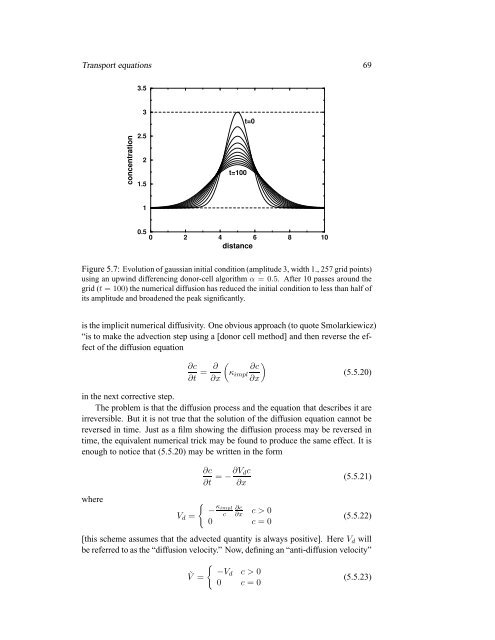Transport: Non-diffusive, flux conservative initial value problems and ...
Transport: Non-diffusive, flux conservative initial value problems and ...
Transport: Non-diffusive, flux conservative initial value problems and ...
You also want an ePaper? Increase the reach of your titles
YUMPU automatically turns print PDFs into web optimized ePapers that Google loves.
<strong>Transport</strong> equations 69<br />
concentration<br />
3.5<br />
3<br />
2.5<br />
2<br />
1.5<br />
1<br />
0.5<br />
t=100<br />
t=0<br />
0 2 4 6 8 10<br />
distance<br />
Figure 5.7: Evolution of gaussian <strong>initial</strong> condition (amplitude 3, width 1., 257 grid points)<br />
using an upwind differencing donor-cell algorithm α = 0.5. After 10 passes around the<br />
grid (t = 100) the numerical diffusion has reduced the <strong>initial</strong> condition to less than half of<br />
its amplitude <strong>and</strong> broadened the peak significantly.<br />
is the implicit numerical diffusivity. One obvious approach (to quote Smolarkiewicz)<br />
“is to make the advection step using a [donor cell method] <strong>and</strong> then reverse the effect<br />
of the diffusion equation<br />
∂c<br />
∂t<br />
�<br />
∂<br />
=<br />
∂x<br />
κimpl<br />
�<br />
∂c<br />
∂x<br />
(5.5.20)<br />
in the next corrective step.<br />
The problem is that the diffusion process <strong>and</strong> the equation that describes it are<br />
irreversible. But it is not true that the solution of the diffusion equation cannot be<br />
reversed in time. Just as a film showing the diffusion process may be reversed in<br />
time, the equivalent numerical trick may be found to produce the same effect. It is<br />
enough to notice that (5.5.20) may be written in the form<br />
where<br />
Vd =<br />
�<br />
∂c<br />
∂t<br />
= −∂Vdc<br />
∂x<br />
∂c<br />
∂x c > 0<br />
− κimpl<br />
c<br />
0 c = 0<br />
(5.5.21)<br />
(5.5.22)<br />
[this scheme assumes that the advected quantity is always positive]. Here Vd will<br />
be referred to as the “diffusion velocity.” Now, defining an “anti-diffusion velocity”<br />
˜V =<br />
�<br />
−Vd c > 0<br />
0 c = 0<br />
(5.5.23)

















